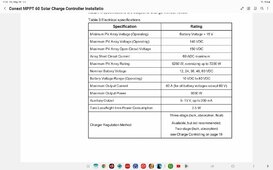Bluedog225
Texas
- Joined
- Nov 18, 2019
- Messages
- 3,268
I’m double checking my maths before hooking up.
When I’m calculating how much I over panel my Victron 150/35, do I use the wattage of the panels divided by the voltage of the system?
E.g.: 9 panels x 275 watts = 2,475 watts
Edit-the in series; three in parallel.
2475/56 volts = 44 amps
26% over
I’ll only be running 28 amps when calculated based on the short circuit voltage times the number of parallel strings per mppt.
I think I’m in the clear right? Thanks.

When I’m calculating how much I over panel my Victron 150/35, do I use the wattage of the panels divided by the voltage of the system?
E.g.: 9 panels x 275 watts = 2,475 watts
Edit-the in series; three in parallel.
2475/56 volts = 44 amps
26% over
I’ll only be running 28 amps when calculated based on the short circuit voltage times the number of parallel strings per mppt.
I think I’m in the clear right? Thanks.






